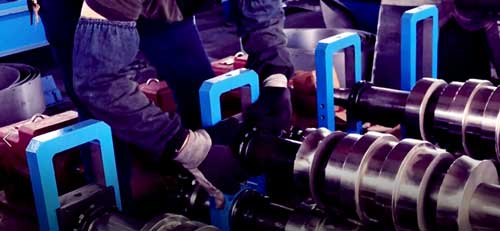How to Adjust Roll Forming Machine
- Home
- How to Adjust Roll Forming Machine
ROLL FORMING MANUAL BOOK
Roll forming machines are widely used in manufacturing industries to create precise, uniform metal profiles. Proper adjustment ensures optimal performance, reduces material waste, and extends the machine’s lifespan. Here’s a step by step guide to adjusting a roll forming machine effectively.

How to set up a roll forming machine
Before making adjustments, thoroughly inspect the machine setup. Check the alignment of the roll tooling, ensure all components are securely fastened, and confirm the materials being processed match the machine’s specifications. Any misalignment or loose parts can lead to defects in the final product. A pre adjustment assessment helps identify potential issues that need correction.
Setup Roller, Assembly Parts to Complete Machine
The most common way is a feeler to adjust roll forming machine the gap of up roller and down roller. engineering should change the gap when material thickness is changed.
likewise, workers should work and record bearing housing positions before moving. this can help as a work-book for workers to have easier machine maintenance and roller gap setup.
In fact, most of the roll forming machine down rollers are fixed and for changing the gap we adjust up roller by a connected screw on bearing housing.
Above all the final roller gap adjusting should be according to gears, bearing tolerance as well. For a higher roller gap will occur result in bigger radii of profile(not precise result) meanwhile sometimes material won’t move forward through stands by a bigger gap. meanwhile, once the roller gap is too tight machine will face several problems such as material marking, roller worn, and the final profile has wrinkle, twisting bow as well.
How Does a Roll Forming Machine Work?
Different materials require specific thickness settings to achieve the desired profile. Adjust the roll gap to accommodate the material thickness while maintaining uniform pressure. Test the settings on a small sample and make incremental adjustments as needed. Proper thickness adjustment reduces material stress and ensures a smooth production process.
Inspect Roll Forming Machine With Raw Material Inside
- Roll forming generally design to form a panel from the center, before we put strips to feeder its highly recommended to cut two sides of strips like the picture, this will help strips feed in the center of rollers.
- Appear deficiency on one stand: Once we occur deficiency on profile after one tolling stand should check the gapping and up roller down roller alignment. Likewise, you can stop the machine and with low speed reverse a little to check roller mark on steel for modifying center line on the roller.
- Wrinkle, and popping, and distortion on stand: Standard roll forming machine with an experienced true designer will working without any popping or wrinkle.
So it happens for two reasons:
First: not enough tooling stand and a mistake on design. most noteworthy each roller stand has designed for forming. More than its capacity make distortion on profile.
Second: up roller and down roller gapping or centerline dis match. It needs to take material out and adjust roller and gap.
Turks head in Roll Forming
Torque head is a complete roller stand with final profile roller shape that not connected to any drive system (chain or gears) and roller turning by profile moving toward. Mean while the support stand for these rollers designed special that can twist up roller and down roller together with adjusted gap.
Also will install in guide line that can easily mowing up and down to fixing profile sweep. In special profile and closed type profile roll forming machine after final stand install torque head or straightening stand. For the reason that some twisting and longitudinal is still left on finished profile so by twisting back wise torque head we can make it straight back.
Conclusion for Turkish head roll forming
After adjusting all tooling stand gapping make sure all roller are in effective position, if any twisting longitudinal bow and sweeping happen you should easily move or twist torque head stand Stand to get standard finished profile. Remember once want to modify torque head it should be with out material inside.
Cutting Unit Roll Forming Machine
For roll forming lines we need to cut off the unit to get requirement profile length. We have two way of cutting strips or panel:
1: pre-cutting: it’s flat blade shearing that install before forming and cut none form material to demand length.
2:shape cutting: install after forming stands, the blade is design same as profile shape, for hydraulic cutting blade or cutting saw that also saw profile after forming.
Cutting Unit Roll Forming Installation:
After material passes all roller stand and also with torque head we adjust profile twisting and longitudinal. Its time to install the cutting unit on the end of the roll forming machine, consequently to make sure cutting blade is in right position and won’t make any distortion or reflection on profile during passing profile through the blade.
FAQ :
Use entrance guides to center the coil and prevent side-walking. Adjust the left and right guide blocks evenly until the strip enters the first forming pass straight.
Input the desired length into the control panel (PLC). Then:
Calibrate the encoder
Check sensors
Run sample cuts
Fine-tune cutting offsets until exact length is achieved.
Routine adjustments should be done:
Every coil change
After roller replacement
When switching to another profile
If product dimensions become inconsistent.
Twisting usually comes from uneven roller pressure. To fix:
Reduce pressure on the side where twisting begins
Adjust horizontal alignment
Check for worn rollers
Ensure entrance guides are centered.
Check:
Roller gap
Roller alignment
Material feeding width
Cutting offset
Material thickness variation
Correct the issue step by step starting from the first forming pass.

